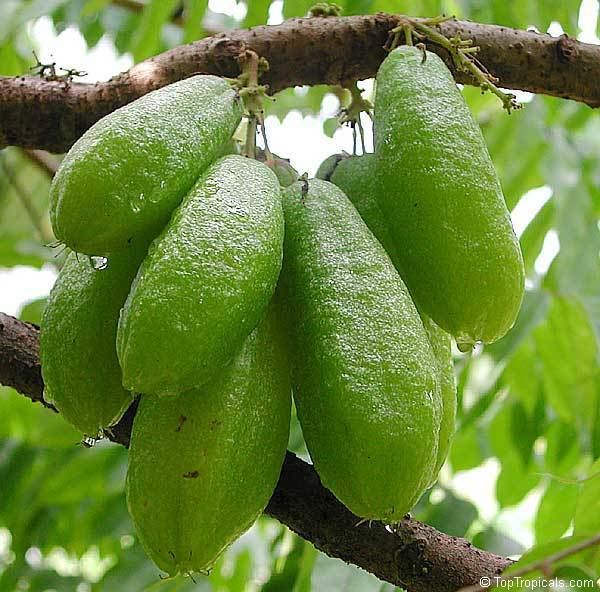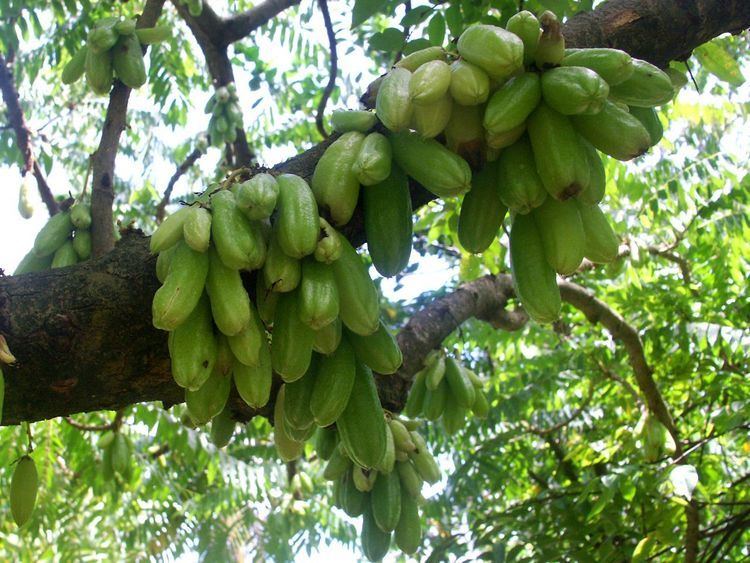Genus Averrhoa Rank Species | ||
 | ||
Similar Carambola, Averrhoa, Phyllanthus acidus, Indonesian bay leaf, Oxalidaceae | ||
Averrhoa bilimbi cucumber tree
Averrhoa bilimbi (commonly known as bilimbi, cucumber tree, or tree sorrel) is a fruit-bearing tree of the genus Averrhoa, family Oxalidaceae. It is a close relative of carambola tree.
Contents
- Averrhoa bilimbi cucumber tree
- Description
- Distribution and habitat
- Nutritional value for 100 g of edible portion
- Culinary interest
- Medical interest
- Other uses
- Vernacular names
- References

Description

The bilimbi tree reaches 5–10 m in height. Its trunk is short and quickly divides up into ramifications. Bilimbi leaves, 3–6 cm long, are alternate, imparipinnate and cluster at branch extremities. There are around 11 to 37 alternate or subopposite oblong leaflets. The leaves are quite similar to those of the Otaheite gooseberry. The trunk and branches of tree has to be exposed to sunlight for fruits to form (traditional knowledge), which is achieved by removing leaves except from branch end.
Distribution and habitat

Possibly originated in Moluccas, Indonesia, the species is now cultivated and found throughout the Philippines, Indonesia, Sri Lanka, Bangladesh, Maldives, Myanmar (Burma) and Malaysia. It is also common in other Southeast Asian countries. In India, where it is usually found in gardens, the bilimbi has gone wild in the warmest regions of the country.

Outside of Asia, the tree is cultivated in Zanzibar. In 1793, the bilimbi was introduced to Jamaica from Timor and after several years, was cultivated throughout Central and South America where it is known as mimbro. In Suriname this fruit is known as lange birambi. Introduced to Queensland at the end of the 19th century, it has been grown commercially in the region since that time.
This is essentially a tropical tree, less resistant to cold than the carambola, growing best in rich and well-drained soil (but also stands limestone and sand). It prefers evenly distributed rainfall throughout the year, but with a 2- to 3-month dry season. Therefore, the species is not found, for example, in the wettest part of Malaysia. In Florida, where it is an occasional curiosity, the tree needs protection from wind and cold.
Nutritional value for 100 g of edible portion
Culinary interest
In the Philippines, where it is commonly found in backyards, the fruits are eaten either raw or dipped in rock salt. It can be either curried or added as a souring agent for common Filipino dishes such as sinigang and paksiw. The uncooked bilimbi is prepared as relish and served with rice and beans in Costa Rica. In the Far East, where the tree originated, it is sometimes added to curry. Bilimbi juice (with a pH of about 4.47) is made into a cooling beverage. In Indonesia, it is added to some dishes, substituting for tamarind or tomato.
Additionally, the fruit can be preserved by pickling, which reduces its acidity. The flowers are also sometimes preserved in sugar.
In another part of Indonesia, Aceh, it is preserved by sun-drying. The sun-dried bilimbi is called asam sunti. Bilimbi and asam sunti are popular in Acehnese cuisine. It can replace mango in making chutney. In Malaysia, it also is made into a rather sweet jam.
In Kerala and Bhatkal, India, it is used for making pickles and to make fish curry, especially with Sardines, while around Karnataka, Maharashtra and Goa the fruit is commonly eaten raw with salt and spice.
In Seychelles, it is often used as an ingredient to give a tangy flavor to many Seychellois creole dishes, especially fish dishes. It is often used in grilled fish and also (almost always) in a shark meat dish, called satini reken.
Medical interest
In the Philippines, the leaves serve as a paste on itches, swelling, rheumatism, mumps or skin eruptions. Elsewhere, they are used for bites of venomous creatures. A leaf infusion is used as an after-birth tonic, while the flower infusion is used for thrush, cold, and cough. Malaysians use fermented or fresh bilimbi leaves to treat venereal diseases. In French Guiana, syrup made from the fruit is used to treat inflammatory conditions. To date there is no scientific evidence to confirm effectiveness for such uses.
In some villages in the Thiruvananthapuram district of India, the fruit of the bilimbi was used in folk medicine to control obesity. This led to further studies on its antihyperlipidemic properties.
The fruit contains high levels of oxalate. Acute kidney failure due to tubular necrosis caused by oxalate has been recorded in several people who drank the concentrated juice on continuous days as treatment for high cholesterol. These people were prompted into consuming this concoction by local media which played up studies done in experimental animals.
Other uses
In Malaysia, very acidic bilimbis are used to clean kris blades. In the Philippines, it is often used in rural places as an alternative stain remover. In Indonesia, its red flowers are sought as an ingredient of natural red dye for traditional textiles.
Vernacular names
The tree and fruit are known by different names in different languages. They should not be confused with the carambola, which also share some of the same names despite being very different fruits. Balimbing in the Philippines actually refers to carambola and not to bilimbi.
